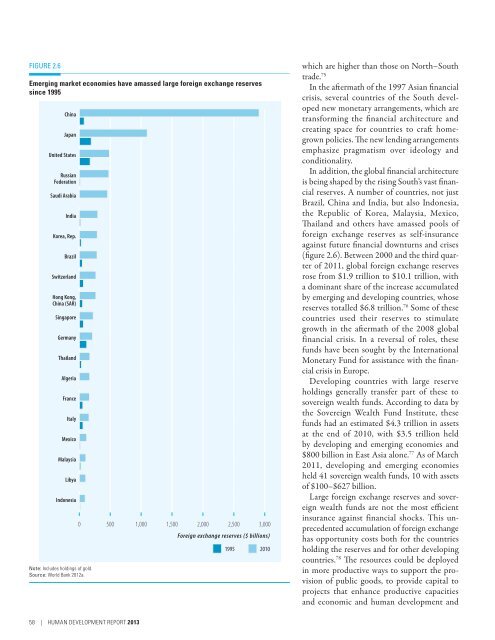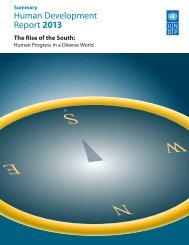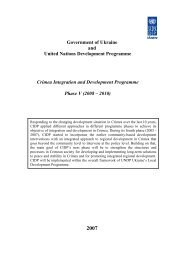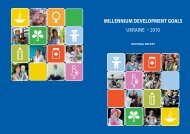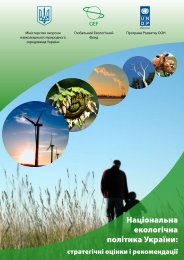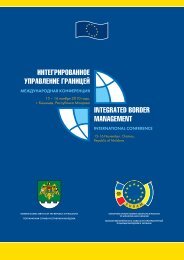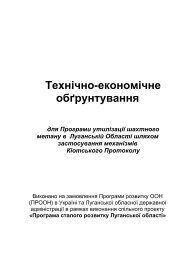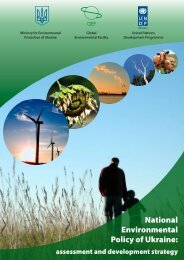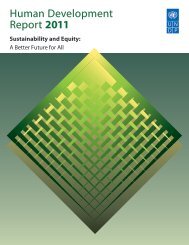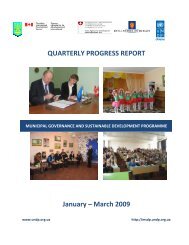E N S W - United Nations Development Programme
E N S W - United Nations Development Programme
E N S W - United Nations Development Programme
You also want an ePaper? Increase the reach of your titles
YUMPU automatically turns print PDFs into web optimized ePapers that Google loves.
Figure 2.6<br />
Emerging market economies have amassed large foreign exchange reserves<br />
since 1995<br />
China<br />
Japan<br />
<strong>United</strong> States<br />
Russian<br />
Federation<br />
Saudi Arabia<br />
India<br />
Korea, Rep.<br />
Brazil<br />
Switzerland<br />
Hong Kong,<br />
China (SAR)<br />
Singapore<br />
Germany<br />
Thailand<br />
Algeria<br />
France<br />
Italy<br />
Mexico<br />
Malaysia<br />
Libya<br />
Indonesia<br />
Note: Includes holdings of gold.<br />
Source: World Bank 2012a.<br />
0 500 1,000 1,500 2,000 2,500 3,000<br />
Foreign exchange reserves ($ billions)<br />
1995<br />
2010<br />
which are higher than those on North–South<br />
trade. 75<br />
In the aftermath of the 1997 Asian financial<br />
crisis, several countries of the South developed<br />
new monetary arrangements, which are<br />
transforming the financial architecture and<br />
creating space for countries to craft homegrown<br />
policies. The new lending arrangements<br />
emphasize pragmatism over ideology and<br />
conditionality.<br />
In addition, the global financial architecture<br />
is being shaped by the rising South’s vast financial<br />
reserves. A number of countries, not just<br />
Brazil, China and India, but also Indonesia,<br />
the Republic of Korea, Malaysia, Mexico,<br />
Thailand and others have amassed pools of<br />
foreign exchange reserves as self-insurance<br />
against future financial downturns and crises<br />
(figure 2.6). Between 2000 and the third quarter<br />
of 2011, global foreign exchange reserves<br />
rose from $1.9 trillion to $10.1 trillion, with<br />
a dominant share of the increase accumulated<br />
by emerging and developing countries, whose<br />
reserves totalled $6.8 trillion. 76 Some of these<br />
countries used their reserves to stimulate<br />
growth in the aftermath of the 2008 global<br />
financial crisis. In a reversal of roles, these<br />
funds have been sought by the International<br />
Monetary Fund for assistance with the financial<br />
crisis in Europe.<br />
Developing countries with large reserve<br />
holdings generally transfer part of these to<br />
sovereign wealth funds. According to data by<br />
the Sovereign Wealth Fund Institute, these<br />
funds had an estimated $4.3 trillion in assets<br />
at the end of 2010, with $3.5 trillion held<br />
by developing and emerging economies and<br />
$800 billion in East Asia alone. 77 As of March<br />
2011, developing and emerging economies<br />
held 41 sovereign wealth funds, 10 with assets<br />
of $100–$627 billion.<br />
Large foreign exchange reserves and sovereign<br />
wealth funds are not the most efficient<br />
insurance against financial shocks. This unprecedented<br />
accumulation of foreign exchange<br />
has opportunity costs both for the countries<br />
holding the reserves and for other developing<br />
countries. 78 The resources could be deployed<br />
in more productive ways to support the provision<br />
of public goods, to provide capital to<br />
projects that enhance productive capacities<br />
and economic and human development and<br />
58 | HUMAN DevELOPMENT REPORT 2013


